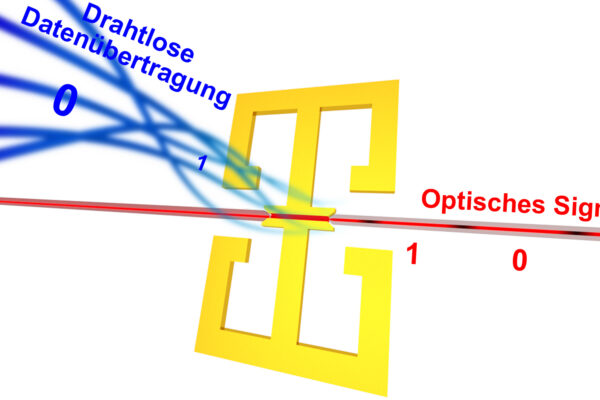
Millimeter wave modulator offers cost-effective “last mile” connection
Due to their high frequency, light waves are ideally suited for fast data transmission. Sent through optical fibers, they can easily transport hundreds of billions of bits (gigabits) per second. The “last mile” from a central fiber optic cable to a home Internet connection is the most complex and costly. Alternatives such as 4/5G mobile telephony are cheaper, but cannot offer all users the high transfer rates required by data-intensive applications such as streaming TV at the same time.
Jürg Leuthold, Professor at the Institute for Electromagnetic Fields at ETH Zurich, and his colleagues, with the support of colleagues from the University of Washington in Seattle, now developed a new type of light modulator with which the last mile can be covered cost-effectively and energy-efficiently with extremely high-frequency millimeter waves.
In order to convert data encoded on millimeter waves into light pulses for transmission in a glass fiber, one normally needs very fast – and therefore expensive – electronic components. The millimeter waves must first be received by an antenna, then amplified and finally fed into a light modulator, which translates the data contained in the millimeter waves back into light pulses.
Leuthold and his colleagues succeeded in building a light modulator that does not require any electronics or batteries. This makes the modulator completely independent of an external power supply and also extremely small, so that in principle it can be attached to any lamppost. From there, it can then receive data from individual houses via millimeter wave signals and feed it directly into the central fiber optic, according to the Swiss researchers.
The ETH researchers’ modulator consists of a chip less than one millimetre in size that also contains the millimetre wave antenna. This antenna receives the millimetre waves and converts them into an electrical voltage. The voltage then drops in the middle of the chip over a thin gap, the actual heart of the modulator.
There is a slot only a few micrometers long and less than a hundred nanometers narrow, which is filled with a material that is particularly sensitive to electric fields. The light beam of the glass fiber is fed into this slot. There, however, unlike in the glass fiber or in the air, the light no longer propagates as an electromagnetic wave but as a so-called plasmon. Plasmons are hermaphrodites consisting of electromagnetic fields and oscillations of electric charges on the surface of a metal. Thanks to this property, they can be confined in a much narrower space than light waves.
The electrically sensitive, non-linear material in the slot ensures that even the smallest electric fields generated by the antenna strongly influence the propagation of the plasmons. This influence on the oscillation phase of the waves is maintained when the plasmons are converted back into light waves at the end of the slot. In this way, the data bits contained in the millimeter waves are transferred directly to the light waves – without detours via electronics and without external energy supply. In the laboratory experiment with 60 gigahertz millimeter wave signals, the researchers were able to demonstrate transmission rates of up to 10 gigabits per second over a distance of five meters and 20 gigabits per second over one meter.
In addition to its tiny size and low power consumption, the new modulator has other advantages. “The direct transmission from millimeter waves to light waves makes our modulator particularly flexible in terms of frequencies and the exact format of the data encoding,” emphasizes Leuthold. The modulator is already compatible both with the new 5G technology and with future industry standards, which provide frequencies of 300 gigahertz and transfer rates of up to 100 gigabits per second. In addition, it can be manufactured using conventional silicon technology and is therefore comparatively cheap.
The report appeared originally in the magazine Nature Photonics
 If you enjoyed this article, you will like the following ones: don't miss them by subscribing to :
eeNews on Google News
If you enjoyed this article, you will like the following ones: don't miss them by subscribing to :
eeNews on Google News


